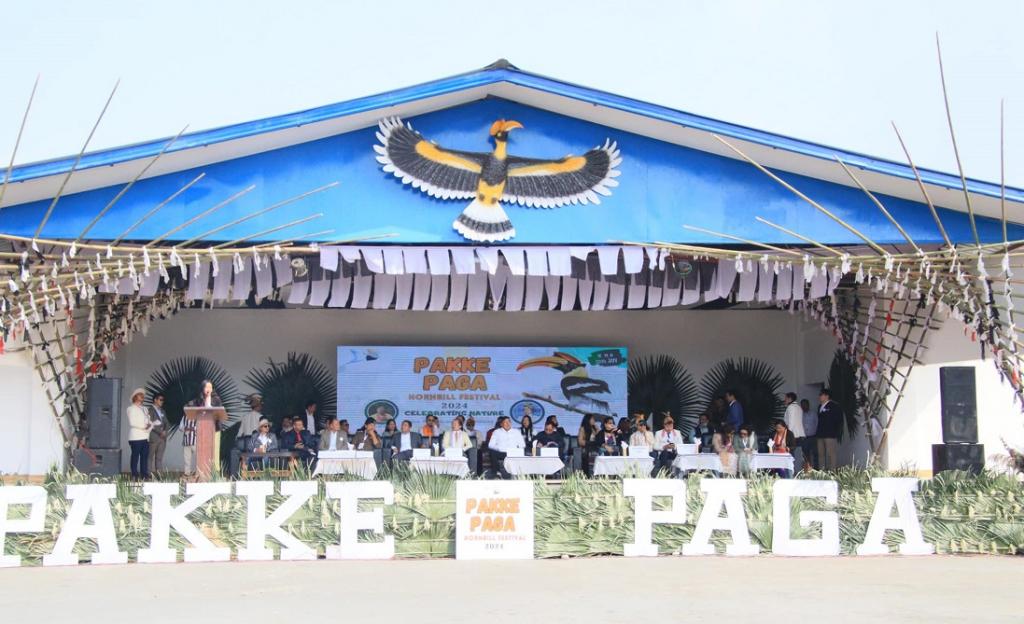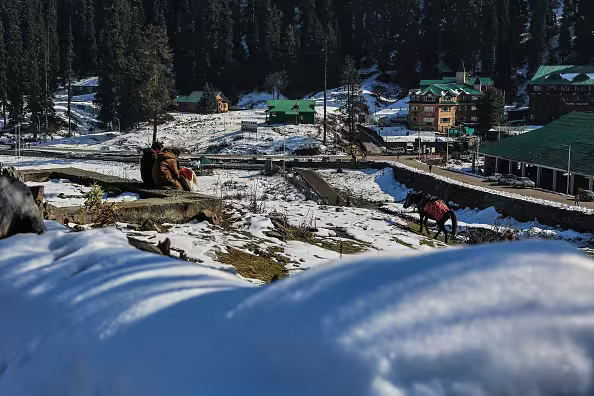Pakke Paga Hornbill Festival begins in Arunachal; effective conservation of iconic birds urged (DTE)

- 19 Jan 2024
Why is it in the News?
The 9th edition of the Pakke Paga Hornbill Festival (PPHF) commenced in the town of Seijosa in Arunachal Pradesh’s Pakke Kessang district on January 18, 2024, with a call to protect and conserve hornbills.
About Pakke Paga Hornbill Festival:
- The first Pakke Paga Hornbill Festival (PPHF) took place in 2015 with the primary goal of acknowledging the Nyishi tribal group's significant role in hornbill conservation within the Pakke Tiger Reserve (PTR).
- Additionally, the festival aimed to generate alternative sources of income for the region and raise awareness across India about the marvels of PTR and its surroundings.
- The current year's festival is themed "Domutoh Domutoh, Paga hum Domutoh," meaning 'Let Our Hornbills Remain' in the Nyishi language.
- The focus of this year's festival is to emphasize the crucial importance of preserving these iconic birds.
About the Great Indian Hornbill:
- The Great Indian Hornbill is a bird family found in tropical and subtropical Africa, Asia, and Melanesia.
- It is the state bird of Kerala and Arunachal Pradesh in India.
- The Great Indian Hornbill is now considered “Vulnerable” due to high hunting pressure, habitat loss, and deforestation.
Key Facts About Pakke Tiger Reserve:
- Pakke Tiger Reserve is located in the East Kameng district of Arunachal Pradesh.
- It is bordered by the Tenga Reserve Forest to the North, the Doimara Reserve Forest to the West, and Nameri National Park and Tiger Reserve (Assam) to the South.
- The region exhibits high species diversity and endemicity, acting as a transitional zone between the Indian and Malayan ecoregions.
- Located North of the Brahmaputra River, Pakke Tiger Reserve is positioned in the transition zone between the Assam plains and the hilly forests of Arunachal Pradesh.
- Vegetation primarily comprises tropical evergreen and semi-evergreen forests.
- Flora: Notable flora includes Polyalthia simiarum, Pterospermum acerifolium, Sterculia alata, Stereospermum chelonioides, Ailanthus grandis, and Duabanga grandiflor. Additionally, about eight species of bamboo are found in the area.
- Fauna: The fauna of the reserve includes iconic species like the Tiger and elephant, as well as predators such as the Leopard and the Clouded leopard, contributing to the rich biodiversity of the region.
ISRO develops second-generation Distress Alert Transmitter (The Hindu)

- 19 Jan 2024
Why is it in the News?
Indian Space Research Organisation (ISRO) has developed an improvised Distress Alert Transmitter (DAT) with advanced capabilities and features for the fishermen at sea to send emergency messages from fishing boats.
What is a Distress Alert Transmitter (DAT)?
- The first version of DAT has been in operation since 2010, allowing fishermen at sea to send emergency messages from their fishing boats.
- These messages are transmitted via a communication satellite to the Indian Mission Control Centre (INMCC), the central control station, where the alert signals are decoded to determine the identity and location of the distressed fishing boat.
- The extracted information is then relayed to Maritime Rescue Coordination Centres (MRCCs) under the Indian Coast Guard (ICG), enabling coordinated Search and Rescue operations to assist fishermen in distress.
About the Second Generation DAT (DAT-SG):
- Leveraging advancements in satellite communication and navigation technology, ISRO has enhanced DAT into the Second Generation DAT (DAT-SG). DAT-SG not only allows fishermen to send distress alerts but also provides them with acknowledgements, assuring them that rescue operations are underway.
- In addition to transmitting distress signals, DAT-SG can receive messages from control centres.
- This feature enables the sending of advance alert messages to fishermen about adverse weather conditions, cyclones, tsunamis, or other emergencies.
- Moreover, the system transmits information on Potential Fishing Zones (PFZs) to fishermen at regular intervals.
- DAT-SG can be connected to mobile phones using a Bluetooth interface, and messages can be read in the native language through a mobile app.
- The central control centre employs a web-based network management system called "SAGARMITRA," which maintains a database of registered DAT-SGs.
- This system assists MRCCs in accessing real-time information about distressed boats, allowing the Indian Coast Guard to initiate Search & Rescue operations promptly during distress situations.
Why Kashmir and Ladakh are without snow this winter, its implications (Indian Express)

- 19 Jan 2024
Why is it in the News?
The Indian Himalayas are experiencing an unusual lack of snowfall this winter, impacting ski resorts and prompting holiday cancellations.
Key Highlights of the Report:
- Unprecedented precipitation deficit: December witnessed an alarming 80% precipitation deficit in the western Himalayan region.
- The ongoing dry spell in January is attributed to the absence of active western disturbances this winter season, as reported by the India Meteorological Department (IMD).
- Impact on freshwater resources: Experts warn of potential impacts on freshwater availability in the Himalayan region.
- The extended dry spell poses a threat to horticulture and agricultural production, raising concerns among experts.
- Unseasonal blooming and alarming temperature anomalies: Despite being peak winter, Ladakh and Kashmir experienced unusually warm temperatures, leading to early crop blooming.
- A report by IMD scientists reveals maximum temperatures 5-8 degrees Celsius below normal over the northern plains since December 29.
- Challenges to water levels and ecosystems: Experts also highlight the significance of the Chillai Kalan snowfall period as the only freshwater source.
- The prolonged dry spell has resulted in reduced water levels in rivers and streams, posing challenges to the region's ecosystems.
Factors contributing to severe weather conditions:
- Scientists attribute the severe weather to three main factors:
- Lack of active western disturbances
- Prevailing El Nino conditions, and
- A strong jet stream.
- El Nino, characterised by abnormal warming in the central Pacific Ocean, contributes to altered weather patterns.
- Mechanics of fog formation: Scientists explain the three conditions required for fog formation: weak low-level winds, moisture, and overnight cooling.
- The lack of strong western disturbances disrupts these conditions, contributing to the prolonged fog.
- Persistent jet streams and cold wave conditions: Strong jet streams prevailing over north India for the last five days have led to the subsidence of cold air, enhancing cold wave/cold day conditions.
These conditions are expected to continue over the next five days, intensifying the challenges posed by the ongoing weather anomalies.
National Quantum Mission to call for proposals to set up four tech hubs (PTI)

- 19 Jan 2024
Why is it in the News?
The government will set up a coordination cell to implement the National Quantum Mission (NQM) with a focus on establishing four technology hubs in the format of consortia of academia, research and development labs and industry.
What is the National Quantum Mission (NQM)?
- The National Quantum Mission (NQM) will assist India take a giant leap into the future of technology.
- India has entered the ranks of the select few nations actively pursuing the advancement of quantum technology by establishing this programme.
- In 2023, the government sanctioned the National Quantum Mission (NQM), spanning from 2023-24 to 2030-31, with the following key features:
- The mission aims to initiate, foster, and amplify scientific and industrial research and development in Quantum Technology (QT), establishing a dynamic and innovative ecosystem.
- Its ultimate goal is to propel quantum technology-led economic growth, foster the QT ecosystem, and position India as a leading nation in the field of Quantum Technologies & Applications.
- It willl be implemented by the Department of Science & Technology (DST) under the Ministry of Science & Technology.
Key Objectives:
- Develop intermediate-scale quantum computers with 50-1000 physical qubits across platforms like superconducting and photonic technology within eight years.
- Implement satellite-based secure quantum communications over a 2000-kilometre range within India, ensuring long-distance secure quantum communications with other countries.
- Establish inter-city quantum key distribution over 2000 km and multi-node Quantum networks with quantum memories.
- Develop highly sensitive magnetometers in atomic systems and Atomic Clocks for precision timing, communications, and navigation.
- Support the design and synthesis of quantum materials like superconductors, novel semiconductor structures, and topological materials for quantum device fabrication.
- Develop single photon sources/detectors and entangled photon sources for applications in quantum communications, sensing, and metrology.
Implementation:
- The mission involves the establishment of four Thematic Hubs (T-Hubs) in leading academic and National R&D institutes, focusing on Quantum Computing, Quantum Communication, Quantum Sensing & Metrology, and Quantum Materials & Devices.
- These hubs will concentrate on generating new knowledge through basic and applied research and promote R&D in their respective domains.
Significance:
- NQM has the potential to elevate India's Technology Development ecosystem to global competitiveness.
- It is expected to significantly benefit various sectors such as communication, health, finance, and energy, with applications ranging from drug design to space, banking, and security.
- The mission aligns with national priorities, including Digital India, Make in India, Skill India, Stand-up India, and Start-up India, and contributes to Sustainable Development Goals (SDG).
- With the launch of this mission, India will be the seventh country to have a dedicated quantum mission after the US, Austria, Finland, France, Canada and China.
What is Quantum Technology?
- The term "quantum technology" is used to describe the research and development of techniques to build supercomputers with enhanced speed, security, and efficiency in data processing above conventional computers.
- Quantum mechanics, which governs the behaviour of subatomic particles, is used to design these novel systems.
- The peculiar characteristics of subatomic particles are the key to quantum technology's capabilities in processing massive quantities of information concurrently.
Telco body seeks USOF, tax reliefs in FY25 Union Budget (Live Mint)

- 19 Jan 2024
Why is it in the News?
Telecom services providers have urged the Ministry of Finance to suspend the Universal Service Obligation Fund (USOF) till the existing corpus is exhausted.
About Universal Service Obligation Fund (USOF):
- The USOF was established through a parliamentary amendment to the Indian Telegraph (Amendment) Act, 2003.
- Its primary goal is to ensure non-discriminatory access to affordable telecom services in rural and remote areas, thereby narrowing the digital gap between urban and rural regions.
- For financially unviable rural and remote areas, the USOF provides subsidy support in the form of Net Cost or Viability Gap Funding (VGF).
- This encourages telecom service providers to expand their services to these areas, enhancing telecommunications and broadband accessibility.
- Funding Mechanism: Telecom operators contribute to the USOF through a Universal Service Levy (USL), a percentage of their Adjusted Gross Revenue (AGR).
- Administration: The USOF is overseen by the Administrator, USO Fund, appointed by the Central Government.
- It operates as an attached office under the Department of Telecommunications (DoT), Ministry of Communications.
Telecom Technology Development Fund (TTDF):
- Launched by USOF on October 1st, 2022, the TTDF Scheme targets domestic companies and institutions engaged in designing, developing, and commercializing telecommunication products and solutions.
- The scheme aims to facilitate affordable broadband and mobile services in rural and remote areas.
- The initiative fosters connections between schools and diverse volunteers from the Indian Diaspora, including young professionals, retired teachers, retired government officials, NGOs, private sector companies, corporate institutions, and more.
- Under the scheme, USOF is committed to developing standards to meet nationwide requirements and establishing an ecosystem for research, design, prototyping, use cases, pilots, and proof-of-concept testing.
- The scheme provides grants to Indian entities, encouraging the integration of indigenous technologies tailored to domestic needs.
Cellular Operators Association of India (COAI)
- The Cellular Operators Association of India (COAI), was constituted in 1995 as a non-governmental society registered under the Societies Act, 1860.
- The Association is dedicated to the advancement of modern communications through the establishment of a world-class cellular infrastructure and to delivering the benefits of affordable mobile communication services to the people of India.
- Today it is regarded as an important interface between the main stakeholders of the Indian Telecom Ecosystem, i.e. Government, Operators, Consumers, Equipment Manufacturers, and Content Providers.
- COAI provides a forum for discussions and exchange of ideas between Service Providers, Policy Makers, Regulators, Technologists, etc., who share a common interest in the development of mobile telephony in the country.
